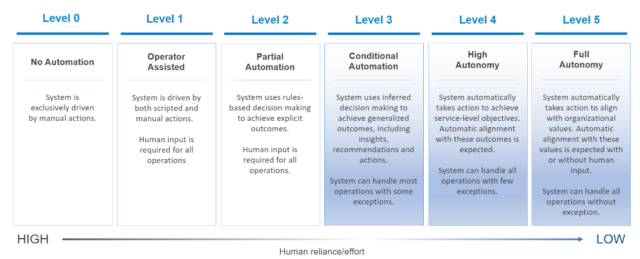Data has become one of my favorite things to talk about.
Why? Because the digital and do-from-anywhere economy is increasing the already massive amounts of data being generated. This creates opportunity for those who can manage that data and use it to generate meaningful insights—quickly and at scale.
But organizations are still struggling with how to gain insights from all this data, not to mention how to manage, store and protect it. This puts unprecedented strain on IT departments as they try to keep up. It’s not simply a matter of having enough infrastructure. In many cases, there simply isn’t enough technical talent available to ensure that IT is supporting the needs of the business and enabling it to remain competitive and grow.
In the face of these challenges, how do we transform IT operations to leverage the power of data with speed and at scale, so the business itself can transform into a modern, digital business? Automation is the key, particularly in a world where data is no longer just in the data center, but also at the edge, in public and private clouds, and in colocation data centers.
With AIOps-driven autonomous operations as part of your IT strategy, you can get deeper access to operational data and the ability to act on it through automation at the infrastructure level. This enables existing technical staff to focus on higher-value activities, whether that’s completing security audits, developing new business apps, or being able to respond and support new business opportunities.
A model to support your autonomous operations journey
We’ve developed a clear framework for autonomous operations that takes into account differing requirements and stages in the journey. And while the journey isn’t necessarily linear, each progression can deliver substantial productivity gains.

Organizations that prioritize higher levels of automation are best equipped to address the needs of a modern digital business.
One of our building blocks for helping customer prioritize autonomous operations is Dell EMC CloudIQ — a cloud-based AIOps application that utilizes machine learning (ML) and predictive analytics to help root out issues long before they can seriously impact your business. This intelligent software is designed to bring greater insight into your Dell EMC infrastructure, to help accelerate daily IT administration workflows and mean time to resolution. With new support for PowerEdge servers available now and PowerSwitch networking planned for October announced today, CloudIQ will span the entire Dell EMC portfolio — hyperconverged/converged infrastructure, compute, storage, networking, and data protection.
This means that IT ops teams will have one UI and a single source of health notifications and recommended actions, real-time reports, and AL/ML driven analytics for their entire fleet of Dell infrastructure systems across all locations. CloudIQ also monitors data protection in public clouds enabled by Dell EMC PowerProtect and storage-as-a-Service enabled by Dell Technologies APEX Data Storage Services.
Currently, the combined intelligence of CloudIQ and the Dell EMC infrastructure portfolio supports up to Level 3 of the autonomous operations model for a sizeable and growing number of IT administration use cases. And we envision higher levels of autonomy for the future.

More automation, more productivity, more efficiency
According to a recent user survey that we conducted, CloudIQ accelerates time to resolution of infrastructure issues anywhere from 2x to10x¹. A great example of this in action is at Plex Systems, the prominent provider of cloud-delivered smart manufacturing solutions, where CloudIQ yields 3x faster time to resolution and productivity gains of 16 hours saved per week according to their manager of cloud operations, Darrel Schueneman.
We expect CloudIQ to deliver even greater efficiencies by integrating its AIOps intelligent insights with third-party IT tool using application interfaces like Webhook, planned for general availability this month, and REST API, planned for general availability in October. These interfaces are designed to drive high levels of automation by integrating CloudIQ data, notifications, and recommended actions with tools like ServiceNow, Slack, Microsoft Teams, Ansible and vRealize.
Decades of software innovation driving intelligent infrastructure
Dell Technologies has been on a decades-long journey to deliver software that radically simplifies IT. Our commitment to automation through software innovation has allowed us to achieve service levels such as 99.9999% availability that our Dell EMC VxRail hyperconverged infrastructure is designed to deliver², on average 85% time-savings for typical administrative tasks when utilizing our OpenManage software for PowerEdge servers³, up to 98% time-savings to maintain a high availability storage environment with PowerStore4, and the ability to automate 99% of network configuration tasks for PowerEdge with ESXi, PowerStore, PowerScale and VxRail using PowerSwitch with OS10 SmartFabric Services5.
This commitment to your autonomous operations journey translates to better outcomes—in your data center or through our APEX portfolio of as-a-Service offerings, and we’re here to support you every step of the way.
I encourage you to watch the replay of our Autonomous Operations event, hosted by Mark Hamill (yes, that Mark Hamill) and featuring a panel of IT experts. In addition to seeing CloudIQ in action, you’ll learn more about how data is driving autonomous operation as a business imperative, the impact of autonomous operations across industries, the benefits to you and your customers, and how Dell can help you on the journey.

1 Based on a Dell Technologies survey of CloudIQ users conducted May through June 2021. Actual results may vary.
2 Based on Dell Technologies field performance, July 2020. Actual results may vary.
3 Based on a Principled Technologies Report commissioned by Dell Technologies, “Performing Common Systems Management Tasks with Dell EMC OpenManage Enterprise 3.5 vs Manual approaches”, March 2021. Actual results may vary.
4 Based on Dell analysis of staff time required to deploy and maintain high availability array with Dell’s Dynamic Resiliency Engine (DRE) vs. traditional RAID. Actual results may vary.
5 Based on Dell analysis of SmartFabric Services versus manual network configuration, September 2021. Actual results may vary.
